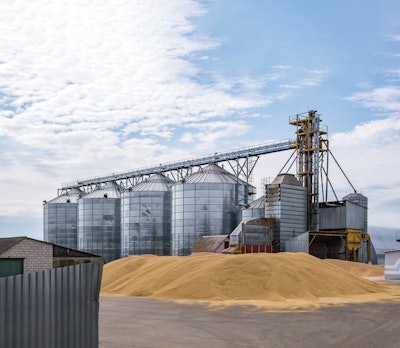
The North American grain industry had slow growth and export challenges throughout 2023. Looking ahead into 2024, emerging risks could depress profit margins and challenge traditional business models. After enjoying high profits for several years, it seems the ag industry may have to brace for a slowdown in the crop cycle beginning in 2024. The possibility of lower grain prices and some financial pressure on the farm means grain operations should begin preparing now.
Feed & Grain asked grain industry leaders to share their thoughts on what challenges might arise in 2024. Here’s what they had to say.
1. Grain storage improves, bushels remain elusive
Chuck Kunisch, president, GEAPS board of directors, and safety director, Michigan Agriculture Commodities (MAC): As we head into 2024, one of the first issues grain elevators will have to deal with is after two years of inverted futures markets, a global abundance of corn and soybeans has significantly improved the profit outlook for elevators storing grain. They can buy on a cheaper basis and benefit from bigger carries in futures markets.
Farmers, though, have been reluctant to sell. Corn and soybean prices have fallen sharply from their peaks earlier this year, frustrating merchandisers’ efforts to take ownership. With farmers reluctant to sell at current prices, some elevators are making up for their shorter grain position by charging higher rates on storage or utilizing delayed pricing (DP), which allows farmers to deliver grain to the elevator and price the commodity later.
For elevators using DP to acquire corn and soybeans now, monthly DP rates should be adequately priced to account for the greater financial risk to the elevator of selling bushels that are not yet priced by the farmer.
The wild card that could return futures markets to an inverse and tighten basis is exports. U.S. corn and soybean exports could be awakened by a poor Brazilian harvest, a continued resurgence of Chinese demand, a return to more normal water levels on the Mississippi River and weakness in the U.S. dollar.
Stephen Nicholson, global sector strategist – grains, Rabo AgriFinance: From the U.S. market perspective, domestic demand will remain strong while exports and, specifically, elevation margins will continue to be weaker than historically, so grain handlers will focus needs and turn to domestic markets.
2. Labor issues continue
Jeff Jones, vice president of operations, MKC: As grain handling operators throughout the country, labor continues to be a huge challenge for the industry. Rural communities are struggling with wage inflation this past year. It’s difficult for small businesses and, in our case, country elevators to keep up with such a large wage increase.
MKC has worked diligently to change our mindset and provide opportunities to offset this increase. Our solution has been to create and offer new opportunities for employee growth within the company. We have partnered with the state of Kansas to offer a one-of-a-kind apprenticeship program in grain handling. We have also ramped up our recruiting efforts with an aggressive intern program and, this past year, created an internal LDA program (leadership development program) to give new employees clear paths to advancement.
3. Supply chain issues improve, but linger
Mike Seyfert, president and CEO, National Grain and Feed Association (NGFA): Transportation is always a top issue. We're in much better shape, from what I’m hearing from our members, than we were 12 to 18 months ago. Rail seems to be doing better, not that there aren’t issues here and there, and we seem to be in a better spot as well with trucking. There are still areas that can be challenging, but rail and trucking are in a better spot than they were a year ago.
Obviously, the Mississippi River has been a challenge for the waterways system. Exports are down in general so less is going down the river. While that's not necessarily good, the Army Corps of Engineers saw this coming, so they're doing more dredging. We also saw a strike on the Canadian side get worked out on the St. Lawrence River.
The big issue we are watching is the Columbia and Snake River and some proposals to remove or breach the dams there. A big proposal was leaked [in early December 2023] as part of the mediation process. The White House has negotiated with some tribal governments that would appear to lay the groundwork for making a case for breaching the dams. That's a major concern to our membership because it impacts the transportation system, and not just members in the (Pacific Northwest), but back into the interior and the export flows and markets.
Nicholson, Rabo AgriFinance: If the weather doesn’t turn around, river logistics will remain challenging, driving freight costs higher and interior grain prices lower.
4. Increased biofuel demand, soybean crush
Jeff Trudell, a member of GEAPS board of directors and processing sales rep for BCI-Bulk Conveyors Inc.: The expansion of crush capacities we are seeing today is to supply the growing biodiesel demand. Just about every crush plant I know is expanding or building new to meet this demand. This is the largest expansion of this industry since the late 1970s/early 1980s.
I keep thinking we can’t grow this market any larger, then another round of new plants or plant expansions is announced. I’m honestly not sure how long this expansion will last. The indicator I will look at going forward will be the acceptance of biodiesel in the transportation industry, as well as what market can be created for the byproduct soybean meal. I’m hearing about export opportunities switching from soybeans to meal, so that’s very positive.
Nicholson, Rabo AgriFinance: We expect the crush capacity to continue to increase into the 2027-28 crop year then begin to level off. At that point, not only will all the facilities be completed but crushing margins will fall off due to oversupply of meal.
Jeff Van Pevenage, Columbia Grain International (CGI) president and CEO: CGI predicts more oilseed processing will come online in 2024 due to the growing biofuel demand that has occurred over the past few years in the U.S. and Canada. We’re expanding our Great Falls, Montana, facility for enhanced oilseed production capacity, while opening more opportunities for producers which will allow them to grow more oilseeds as a rotational crop in Montana.
5. Rising cost of carry will force lower bids
Kunisch, GEAPS and MAC: Grain merchandisers have endured rising costs of storing, or carrying, grain and oilseed inventories over the past year due to rising interest rates, high crop prices and rising operating costs like transportation, insurance, fuel, electricity and labor. CoBank forecasts the financial cost of carry will reach record highs in the upcoming 2023-24 crop year for corn, wheat and soybeans.
The rapidly rising cost of carry is motivating stakeholders in opposite ways: Grain merchandisers want to move inventory faster while end users want to delay taking ownership to minimize their own inventory costs. Cooperative elevators are required to buy and market their members’ grain and oilseeds, regardless of whether the economics of storing and handling commodities are favorable. Grain co-ops, though, have control over their local bid.
The inverted futures markets (when later-dated futures contracts are priced lower than nearby contracts and do not cover the cost of storage) further penalize elevators for storing grains and oilseeds. If interest rates maintain their current high level and futures markets remain inverted into the new crop year, many grain cooperatives will lower bids and widen their basis to cover the high cost of storing commodities.
6. Cost of doing business keeps rising
Van Pevenage, CGI: The cost of operating our business is made up of several items that have drastically increased our cost and affected the revenue side, and it cannot be controlled by just raising prices and margins. First, it is very difficult to find labor and it's expensive to compete with other industries that may have better control from the revenue side. In rural American settings, it's getting more difficult to find employees and the cost of competing with manufacturing and oil companies is expensive.
Second, we've seen astronomical construction and maintenance costs in our industry. As other CEOs would agree, it's becoming increasingly harder to make projects pencil with an economic return today.
Finally, we are battling high interest costs, which appear to be here to stay for the next several years. We operate a low-margin business which requires large sums of working capital to finance. We will either need to lengthen out our payment terms to producers or struggle to cover the interest costs.
Kunisch, GEAPS and MAC: Agricultural cooperatives and private grain companies across the U.S. are facing an environment of increasing property insurance costs and, in some cases, limited availability of coverage.
In short, catastrophic natural disasters are leading to higher property insurance costs. The cost of property/casualty premiums has risen sharply for the 2023 renewal season (between 25% and 75%), following a period of above average property losses due to natural catastrophes. Losses from extreme weather totaled nearly US$170 billion in 2022 versus US$155 billion in 2021, well above the long-term average.
Cooperatives and privately held grain companies will need to explore alternative risk transfer mechanisms including self-insuring through the creation of a captive insurer, merging with another cooperative in a different region to achieve greater businesses diversification and/or creating some form of contingent capital facility with a strategic partner outside of the traditional ag retailing industry.



















